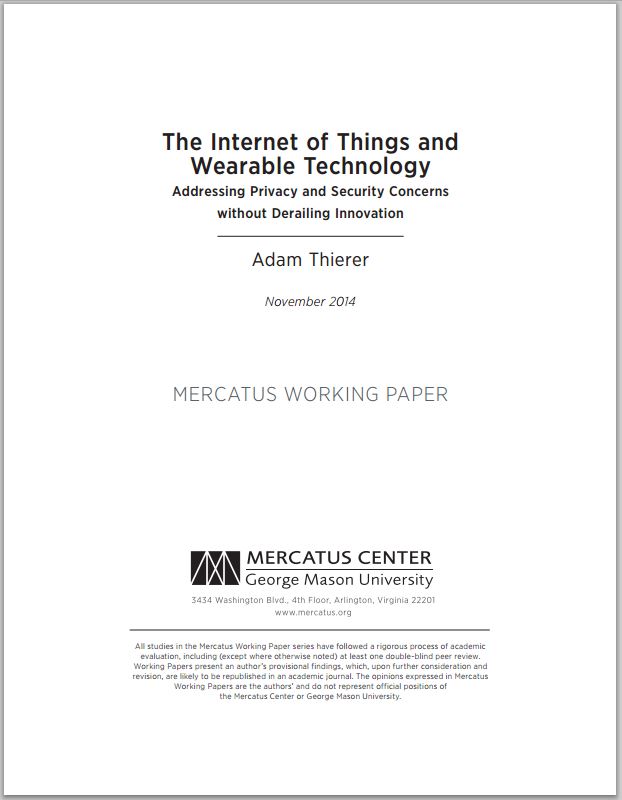 The Mercatus Center at George Mason University has just released my latest working paper, “The Internet of Things and Wearable Technology: Addressing Privacy and Security Concerns without Derailing Innovation.” The “Internet of Things” (IoT) generally refers to “smart” devices that are connected to both the Internet and other devices. Wearable technologies are IoT devices that are worn somewhere on the body and which gather data about us for various purposes. These technologies promise to usher in the next wave of Internet-enabled services and data-driven innovation. Basically, the Internet will be “baked in” to almost everything that consumers own and come into contact with.
The Mercatus Center at George Mason University has just released my latest working paper, “The Internet of Things and Wearable Technology: Addressing Privacy and Security Concerns without Derailing Innovation.” The “Internet of Things” (IoT) generally refers to “smart” devices that are connected to both the Internet and other devices. Wearable technologies are IoT devices that are worn somewhere on the body and which gather data about us for various purposes. These technologies promise to usher in the next wave of Internet-enabled services and data-driven innovation. Basically, the Internet will be “baked in” to almost everything that consumers own and come into contact with.
Some critics are worried about the privacy and security implications of the Internet of Things and wearable technology, however, and are proposing regulation to address these concerns. In my new 93-page article, I explain why preemptive, top-down regulation would derail the many life-enriching innovations that could come from these new IoT technologies. Building on a recent book of mine, I argue that “permissionless innovation,” which allows new technology to flourish and develop in a relatively unabated fashion, is the superior approach to the Internet of Things.
As I note in the paper and my earlier book, if we spend all our time living in fear of the worst-case scenarios — and basing public policies on them — then best-case scenarios can never come about. As the old saying goes: nothing ventured, nothing gained. Precautionary principle-based regulation paralyzes progress and must be avoided. We instead need to find constructive, “bottom-up” solutions to the privacy and security risks accompanying these new IoT technologies instead of top-down controls that would limit the development of life-enriching IoT innovations.
The better alternative is to deal with concerns creatively as they develop, using a balanced, layered approach involving many different solutions, including: educational efforts, technological empowerment tools, social norms, public and watchdog pressure, industry best practices and self-regulation, transparency, torts and products liability law, and targeted enforcement of existing legal standards as needed.
Generally speaking, patience, humility, and forbearance by policymakers is crucial to allowing greater innovation and consumer choice in this arena. Importantly, policymakers should not forget that societal and individual adaptation will play a role here, just as it has during so many other turbulent technological transformations.
This article can be downloaded on my Mercatus Center page, on SSRN, or at Research Gate. I am hoping to find a law or policy journal interested in publishing this paper soon. If you with a journal and are interested, please contact me. [UPDATE 12/3/14: This paper has been accepted for publication in the Richmond Journal of Law & Technology, Vol. 21, Issue 6 (2015).]
Finally, if you are interested in this topic, you might want to flip through these slides I prepared for a presentation on this topic that I made at the Federal Communications Commission in September:
- “The Growing Conflict of Visions over the Internet of Things & Privacy,” January 14, 2012
- “Can We Adapt to the Internet of Things?” IAPP Privacy Perspectives, June 19, 2013
- My Filing to the FTC in its ‘Internet of Things’ Proceeding, May 31, 2013
- Permissionless Innovation: The Continuing Case for Comprehensive Technological Freedom (2014)
- [Video] Cap Hill Briefing on Emerging Tech Policy Issues (June 2014)
- “Why Permissionless Innovation Matters” (4/24/14),
- “How We Learn to Cope with Technological Change” (6/30/14)
- “Problems with Precautionary Principle-Minded Tech Regulation & a Federal Robotics Commission” (9/22/14)

 The Technology Liberation Front is the tech policy blog dedicated to keeping politicians' hands off the 'net and everything else related to technology.
The Technology Liberation Front is the tech policy blog dedicated to keeping politicians' hands off the 'net and everything else related to technology.